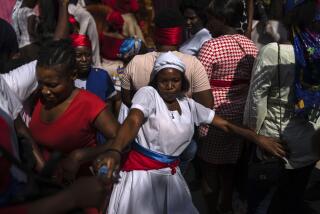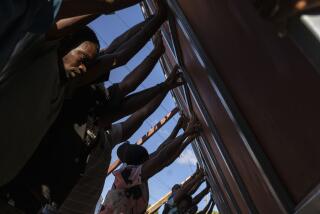Portraits From an Unseen Haiti : Marie-Yolande Saint-Fleur Risked Death to Photograph Life in Her Homeland, Driven By Passion for Her Work and a Sense of History
- Share via
Long before the glare of international media lights found Haiti, photojournalist Marie-Yolande Saint-Fleur was gathering its quotidian realities through her lens.
She put her life at risk to capture moments of the carnage playing out in city streets. But Saint-Fleur’s greater contribution to history may be her pictures of everyday life, eight years’ worth, that fill the gaps left by outsiders drawn more by flash than substance.
Tontons Macoutes and attaches tailed her, threatened her and shot at her, but she kept her commitment to a simple purpose: Photograph everything. Relying on her knack for theatrics, she stayed at least one pace ahead of her persecutors while recording images of everything from voodoo rituals to presidential inaugurations and even, she says, “things as simple as a rock.”
For following her passion, for risking torture or death, Saint-Fleur will receive the fifth annual International Women’s Media Foundation Courage in Journalism Award on Tuesday in New York. The other recipients are Christiane Amanpour, a foreign correspondent for the Cable News Network, and Razia Bhatti, an editor for Pakistan’s Newsline magazine.
“(Saint-Fleur) had nothing going for her at the time that she was putting herself on the line, doing what she felt she had to do,” says Kathy Bushkin, foundation co-chair and editorial manager for U.S. News & World Report.
While many journalists working in Haiti enjoy a measure of protection through ties to a large news organization or a foreign government, Saint-Fleur had none.
In fact, the committee had considered giving the award to another Haitian journalist, Edwige Balutansky. But, in a stirring letter, she asked that the organization pass her up in favor of Saint-Fleur.
“She has been through very difficult times, and I felt she deserved it more than I did,” says the former Reuters correspondent, explaining that her light skin and influential friends made her less vulnerable to military hounding.
Reached in Miami, Saint-Fleur, 31, speaks via a telephone conference call that includes a translator. A lifetime of speaking Creole gives her syllables a twang often found in the villages of southern France.
Strapped for cash, Saint-Fleur has been staying with friends since arriving as a refugee six months ago. She is accustomed to the itinerant lifestyle.
Within months of beginning her first photography course in 1986, she embarked on a career that would force her into hiding. “I, like so many other journalists, could not sleep at home,” she wrote in her unsuccessful 1993 application to the United States for political asylum.
Her brother Joseph had enrolled her in a Port-au-Prince photography school, believing the art form would match his sister’s temperament. She always had the ability to reach people, touch them through theater, music, art, poetry and dance, he explains in a telephone interview from France. “She has the sense of human contact.”
Besides, in Haiti, one takes opportunity as it comes, he says, and he knew the school director.
Saint-Fleur quickly abandoned her other interests. Within a year, her matter-of-fact pictures of Haitians outside the school walls drew the attention of an international literacy group that hired her to photograph Haiti’s poor for its promotional and educational materials. Free-lance work for newspapers followed. So did the threats and warnings.
In the summer of 1987, after completing school, Saint-Fleur rented a room outside Petionville, a town near Port-au-Prince. One day, a doctor surprised her with a warning: Be careful. When she asked why, he responded with a Haitian proverb: “If I give you water, I should not have to show you how to take a bath.”
Haiti was then in the hands of Gen. Henri Namphy’s military regime. Fearing populist reprisal, the attaches --civilian thugs used as instruments of terror by the military--tended to target public figures, including journalists, after dark, Saint-Fleur says. She stopped sleeping at home, finding safety in the homes of friends.
The 1991 election of President Jean-Bertrand Aristide introduced a brief period of relative freedom and safety. Saint-Fleur and five others formed the Agence Haitienne d’Images, a collective dedicated to filling the void in Haiti’s visual history and providing an archive for writers, journalists and scholars.
They would pinpoint a spot in the tiny country, roughly the size of Vermont, then drop in for a photo mission. Saint-Fleur focused particularly on children. In Haiti, where three-quarters of the more than 6 million people go hungry, many parents abandon their children to lives of exploitation.
“All the hard work is basically dropped on the children,” she says.
Her photographs depict young girls scavenging water from shallow puddles or lugging large buckets across the countryside and a boy washing a shiny car with sewer water.
Saint-Fleur wanted “to show how the children are living, to have a record on file.”
*
Eventually, her work spiraled toward the unstable vortex of Haitian politics. After Aristide’s election, men accused of being attaches or zinglindos-- bandits who beat and rape women and children--filled the prisons, she says. Saint-Fleur took their pictures, many of which were published in Haiti.
The coup d’etat that displaced Aristide on Sept. 30, 1991, brought the release of those Saint-Fleur had photographed, many of them members of the military.
They came after her, she says.
After a member of Agence Haitienne d’Images was found trussed in the sack in which he had been beaten and shot, the group disbanded. While some of Saint-Fleur’s colleagues tried to leave the country, she stayed on, moving constantly for two years among hide-outs, from churches to the houses of friends and family.
She drew upon her education in theater to evade her pursuers. Once, she dressed in robes, masquerading as a nun as she walked out of town. “I used the theater to transform dangerous scenes,” she says.
Another time, an attache caught her focusing a camera on him. He put a gun to her head. Just then, another photographer stepped in. Pointing out the size disparity between his large telephoto lens and Saint-Fleur’s small one, he told the gunman that she simply was not equipped to photograph a military man.
Saint-Fleur played along, asking the attache : “Why would I want to take a photo of you?” Ego deflated, he let her go, she says.
Joseph had no idea whether his sister was alive until last November, when he heard she had fled to the Dominican Republic after the United States rejected her first asylum bid. Then, in March, she finally called from Florida. A human rights group had helped her plead her case.
Saint-Fleur remains cautious. The attaches might have friends in Florida, she says. “I don’t let myself sleep in situations.”
Still, she refuses to live in fear because it “troubles the spirit,” she says. “A bad situation today will change tomorrow. If you let the problem dominate your mind, you may as well quit.”
And she is not about to quit. She keeps busy with English classes and a word-processing course until she can return to Haiti. Saint-Fleur will go back, she says, only “if we can win the moment we had when Aristide was president.”
After years as an independent journalist, she is suspicious of the packaged news coming from her homeland, from reporters who come and go. And as someone who has meticulously documented Haiti’s inner workings, she knows that history cannot always be served up by a camera.
“We know what happens in the street. But the great decisions, those don’t happen where we
More to Read
Sign up for Essential California
The most important California stories and recommendations in your inbox every morning.
You may occasionally receive promotional content from the Los Angeles Times.













